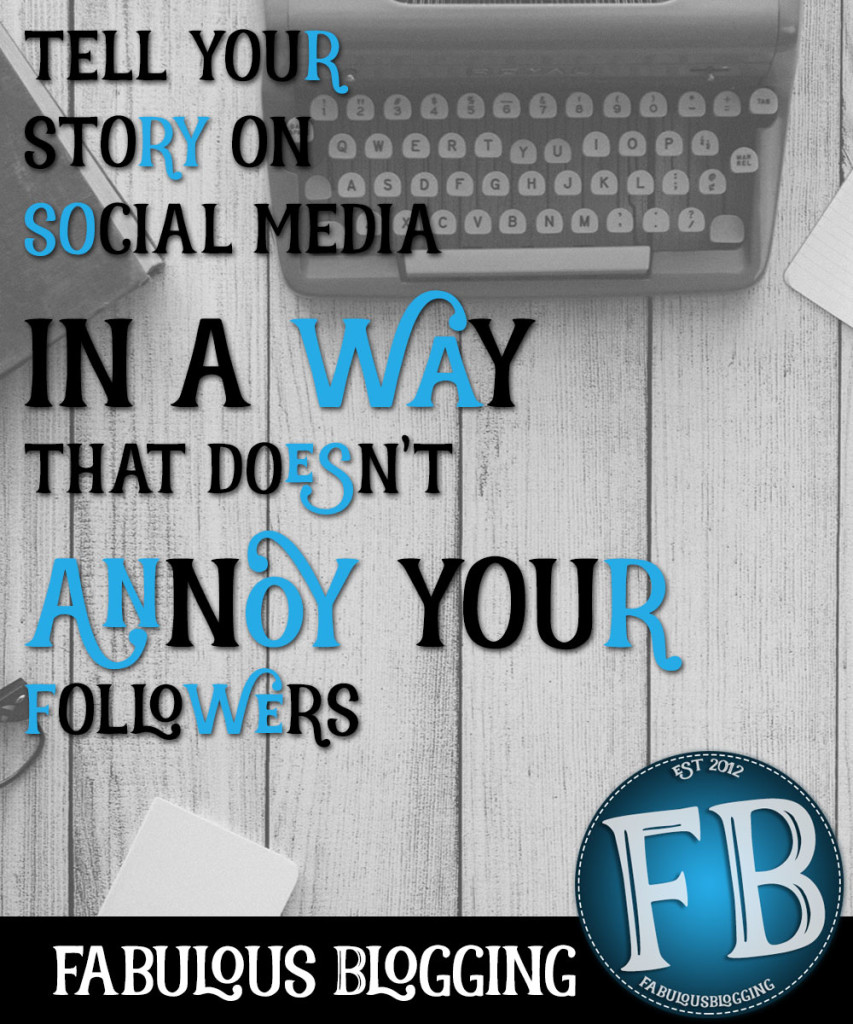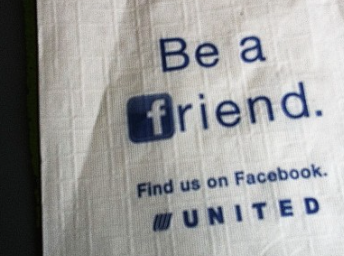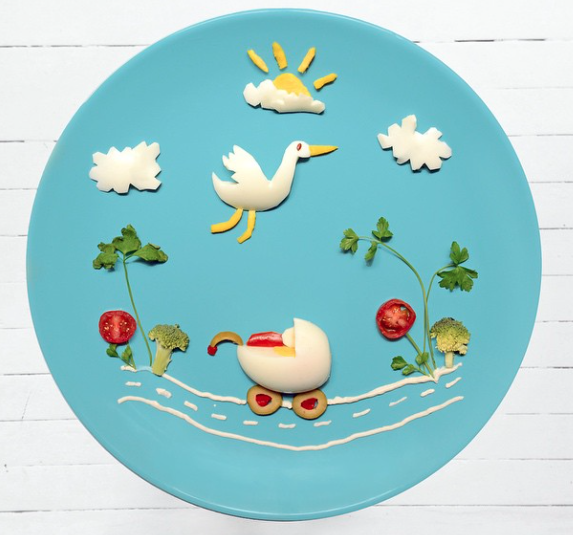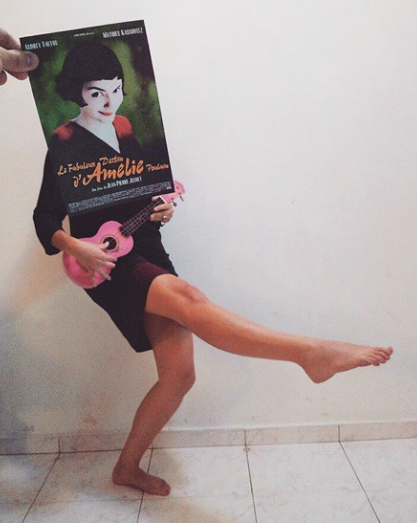It’s never intentional. A blogger or small businessperson starts up a website and quickly realizes that the way to bring traffic to their writing or business is through social media. Within a few weeks, this person is on all platforms, sharing links everywhere, and hoping that the “spray and pray” method will work.
I’m going to stop it right there because I’m sure we’ve all either BEEN that person or known a few of them. It’s annoying, inefficient, and a waste of time. So how do you tell your story and promote your business without annoying the people who follow you?

The first thing to do is to change your mindset about how your blog/website and social channels work together.
When I started on social media, I was constantly thinking about how to drive traffic to my blog. Now I think,
[clickToTweet tweet=”What medium will best present the information I have to share so I can interact and engage with other people?” quote=”What medium will best present the information I have to share so I can interact and engage with other people?”]
In many cases, it might be some place other than your blog, and that’s okay. If you are getting peoples’ attention, making connections, and building your platform, people will inevitably start following you everywhere– including your blog!

1. Stop putting everything everywhere
Wait what? Yes. Stop putting every good idea, cool photo, nifty quote, tutorial, recipe, whatever – on your blog. To really dominate the social media/web scene, it’s important that you invest in each social platform – as an end in and of itself – and not just as a tool to drive traffic. The same goes for sharing the same thing everywhere. You have to decide – based on the information/visual you want to share – what platform will be the best place to engage with other people about it? Here’s a very quick summary of what I suggest:
- Blog – 1000 word minimum, evergreen content, with photos, video, etc.
- Facebook – Fun personal updates about where you are and what you’re doing, personal photos and announcements, links to articles that are thoughtful and useful.
- Twitter – Inspirational thoughts, funny quotes, sarcasm, industry news with links (and a photo).
- Pinterest – Tutorials, Recipes, DIY instructions, all with a pinnable graphic.
- Google Plus – Beautiful photos, mini-blog posts with commentary right on the platform (no link), links to articles that relate to your niche or industry.
- Instagram – Photos (avoid text overlay) – it’s about photography!! You can use the comment section to reference your thoughts.
- Tumblr – Photos and Gifs.
- LinkedIn – Longform blog posts published right on the platform, industry news links, self-help and success type links.
- YouTube – Tutorials, interviews, parodies.
For example, I want my blog to be full of good stuff…all the time. No more 300 word posts, unless I have a damn good reason to write something short. It’s better to concentrate on a piece that is evergreen, can stand on its own over time, and is likely to be indexed by Google because it’s got meat and content and share-ability. People will wait with baited breath for your next post, rather than feeling like, “Oh gee…her again?” Shorter bursts of inspiration are better for social media.
Twitter and Google + especially are great opportunities for daily interaction, anecdotes, debates, discussions, and general exposure to who you are and what you are offering to the world. It’s an easy way to connect with your audience, share a photo, and mini-blog (or sometimes it’s called micro-blogging) because you do it on the platform without sending someone through a link. Facebook and Instagram are personal (Facebook pages are separate – here I’m talking about your profile). Show your human side, even if you are promoting a business. LinkedIn is strictly professional. Pinterest is where creativity and self-help got married.

2. Use life and photos to enhance your story
No matter what topics you cover as a blogger (or businessperson), there are ways to personalize your social interaction, specifically with photos that capture your everyday life. People crave human interaction. This is a vital part of your strategy.
 For example, I write about social media on this blog. It might not be appropriate to write an entire blog post about a social ad I saw sitting on a table at a restaurant, but I could easily take a photo and write up a quick commentary for G+. It’s in my niche, and I’m letting my audience in on the fact that I went to such-a-such a restaurant and wanted to say something about their cute Facebook labeled napkins.
For example, I write about social media on this blog. It might not be appropriate to write an entire blog post about a social ad I saw sitting on a table at a restaurant, but I could easily take a photo and write up a quick commentary for G+. It’s in my niche, and I’m letting my audience in on the fact that I went to such-a-such a restaurant and wanted to say something about their cute Facebook labeled napkins.
I also write about psychology. Maybe I saw an old guy at the grocery store getting talked down to by the cashier. That can be my launching point for a twitter conversation or G+ mini-blog.
Every single platform allows for photos and that’s because visual marketing is effective. Invest in a few apps that will clean up your photos before you share them.
Finally, I invite you to think about this – how many times have you gotten annoyed when someone you follow overshares stupid memes, cat photos, selfies or clearly photoshopped atrocities? Now think about how many times you got annoyed when someone shared an actual photo THEY took while out living life?
Those are the kinds of photos you want to share to help people get to know you!

3. Engage liberally, but share only the best
Most people get this backwards. They share stuff constantly, but forget to comment, inquire, ask questions, and respond. Let’s flip the formula.
What Most People Do – SHARE > ENGAGE
What You Should Do – ENGAGE > SHARE
You will lose credibility if you recklessly share your friends’ stuff when it sucks. You need to put the social back in your social media game, without sacrificing your authority and quality of your streams.
An analogy: Let’s say there are two toy stores in your town. One toy store carries every toy that local townspeople come by and offer to sell. You have to wade through a lot of junk to find the few good pieces. Nuh-uh right?
The other toystore only takes the best stuff. Which one are you going to go to?

LESSON of the DAY — Make people feel heard and important without sacrificing the quality of your platforms. In other words, engage more, but share only the best.

4. Use the 70/30 rule
70% percent of what you share should NOT be self-promotional. That doesn’t mean it can’t be personal, but avoid blasting out your links constantly. 30% of what you share can link directly back to your blog or business. This may help:

5. Enjoy the platform for what it is, or get off
Do you know how many people I’ve run into that are on Twitter and hate it? Get off! Twitter users especially can tell when someone is simply on there because a social media guru said they had to have a Twitter handle for their brand. I see the same thing with LinkedIn and Google +. This leads to the spray and pray method I mentioned earlier – they link drop and leave.
If you authentically enjoy the platform, and engage with people on it, that will shine through and help you build trust and authority.

6. Establish a niche for your channels
If you haven’t read my last post about discovering your niche, you should! Once you’ve done the exercises, you’ll have a bunch of keywords that identify who you are and what you stand for. Your social media platforms should reflect that.
There are a few exceptions I want to mention.
Pinterest: If you’re a technology teacher blogger for example, your boards should circle around those topics. But it’s okay to have a few fun boards that show your personality too (Stars Wars collector, lover of chocolate, etc.). If you’re just starting out on Pinterest, every new profile should have a food board since they are quite popular.
Twitter: People love the funny on Twitter! You can feel free to always show your humorous side here, even if it’s not exactly on target with your niche.
Instagram: If you want to dominate on this platform, you need to take some tips from people who use it to showcase a type of photo. This is what I mean:
CheeseCurlsofInstagram – Every photo is a cheese curl arrangement meant to depict something. Here, it’s the nativity.

Ida Frosk – Food collages are always popular!

Jaemyc – This guy uses movie posters overlaid on real people and friends.

For each of these Instagrammers, they have a branded look and theme to their photos. The possibilities for bloggers are endless! And because no links are allowed in the comments, you don’t even have to stress about promoting yourself all the time. If people like you on Instagram, they will read your bio and check out your site (that’s where you are able to put a link).

7. Be yourself
It sounds so cliche, but it’s a great principle to live by when you’re interacting online. Be who you are in real life. This means that if what you’re about to say, you wouldn’t have the nerve to say to a crowd of people in a restaurant, think twice before posting. Show your human side too; emotion, thoughtfulness, and even imperfections.
In a digital space, humanity captures peoples’ attention.
